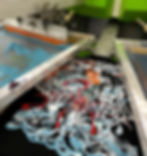Welcome to Your comprehensive guide to screen printing terminology! Whether You're a beginner or a seasoned pro, this screen printing glossary will help You navigate the world of screen printing with confidence. Let's dive in!
Equipment and Basic Components:
AC Servo: Precision-controlled motors used in advanced printing equipment.
Carousel: A rotary screen printing press with multiple print heads and platens.
Carriage: The component housing the squeegee and floodbar on an automatic press.
Flash Cure Unit: A heating device used to partially cure ink between color applications.
Floodbar: The bar on an auto carriage used to flood ink across the screen.
Index Drive: Mechanism (Geneva or Chain Drive) that moves the press systematically.
Infrared Heating Element: Uses specific wavelengths to produce heat in dryers or flash units.
Platen (Pallet/Shirt Board): The surface that holds the substrate during printing.
Pre-Registration Unit (PRU): Used in the darkroom to align multi-color prints.
Print Arm: Connects the print head to the press and houses controls.
Print Head: The part of the press that holds the screen.
Quartz Heating Element: A heating component using quartz bulbs, often in dryers.
Screen: The mesh fabric used to create a stencil for printing.
Spot Gun: A powered spray tool for removing unwanted plastisol ink.
Squeegee: The tool used to push ink through the screen onto the substrate.
Substrates and Materials:
Garment: The fabric item being printed on.
Platen Tape: Protective paper-based tape applied to platens.
Rubylith: A red masking film used to block UV light in screen preparation.
Substrate: Any item being printed on (e.g., t-shirt, poster, mug).
Ink Types and Properties:
Bleed Resistant Inks: Formulated to prevent dye migration in polyester garments.
Discharge Ink: Used to print light colors on dark fabrics by removing the garment's dye.
Gray Blocker/Barrier Base: Ink used to prevent dye migration, typically gray or black.
High Density Ink: Creates a raised, embossed-like effect.
Highlight White: White ink applied last to make designs stand out.
Opacity: How well an ink covers the underlying color of the substrate.
Plastisol Ink: Common textile ink made of PVC, pigments, and plasticizers.
Puff Additive: Makes ink rise to create a 3D effect.
Reducer: Colorless additive used to lower ink viscosity for easier printing.
Thixotropic: Property where ink becomes smoother as it's stirred.
Viscosity: The thickness or thinness of an ink.
Water-based Ink: Eco-friendly inks that can air dry, popular in retail markets.
Color and Design:
Art Proof: A digital mockup sent to the customer for approval.
Bitmap (Raster): An image made of pixels, which can blur when enlarged.
Block Out: Chemical used to cover pinholes or unwanted areas on the screen.
Butt-to-Butt (Butt Registration): Alignment where colors touch without overlapping.
Choke: Reducing the thickness of an image's outer edge to prevent color overlap.
CMYK: Cyan, Magenta, Yellow, and Black - the four colors used in process printing.
Color Separations: Breaking a multi-color image into individual color layers for printing.
Dot Gain: Increase in halftone dot size due to ink spread during printing.
Four Color Process: Halftone printing using Cyan, Magenta, Yellow, and Black.
Ganging: Applying multiple designs to one screen to save time and materials.
Half Tone: A technique that uses dots to create shading and dimension.
Knockout: Removing one color from beneath another for a clearer image.
Lines per Inch (LPI): Measure of screen mesh density; higher LPI allows finer detail.
Moire: An unwanted pattern caused by misaligned halftones or screens.
Overprint: Printing one color on top of another.
Pantone Matching System (PMS): Standardized color system for accurate color matching.
Simulated Process: Halftone printing using 6+ colors to produce a multi-color image.
Spot Color: Discrete color elements in non-photographic images.
Trap: An outline around a fill color to prevent gaps due to misalignment.
Vector: A scalable image made of points and lines, maintaining quality at any size.
Screen Preparation and Stencil Making:
Burn: Exposing an emulsion-coated screen to light to create the stencil.
Computer to Screen (CTS): Directly printing artwork onto a screen from a computer.
Dehaze: Using a caustic cleaner to remove ghosted images from a screen.
Develop (Exposure): Using light to harden emulsion and create a stencil.
Diazo: Photosensitizer chemical used in some emulsions to improve stencil strength.
Direct to Screen (DTS): Another term for Computer to Screen (CTS) technology.
Emulsion: Light-sensitive coating applied to screens to create stencils.
Emulsion Over Mesh (EOM): Measurement of emulsion thickness on the substrate side.
Film Positive: Transparent positive image used as a stencil while exposing a screen.
Ghosting: Faint residual image remaining on a screen after reclaiming.
Inkwell: The depth of the emulsion gasket on a screen, dependent on EOM.
Photopolymer: Fast-developing, high-solids emulsion typically used for plastisol printing.
Pinholes: Tiny unwanted spots in the stencil, often due to poor screen prep.
Reclaim: Removing old emulsion to reuse a screen.
REG Mark: "Crosshair" target marks used for aligning screen images.
Stencil: The portion of an exposed screen containing the image to be printed.
Wash Out: Rinsing the screen after exposure to reveal the stencil.
Printing Techniques and Processes:
3D Flood: Technique used for thick stencils where the print head floods and prints before final application.
Clearing: The act of pushing ink through a screen.
Color Change: Cleaning out a screen and putting in a different color of ink.
Double Index: Moving auto press platens twice to print on every other platen.
Dwell Time: Amount of time a flash dryer fires over the substrate.
Even/Odd: Setting the auto press to print on every other platen.
Fetch/Go-To Platen: Automatically bringing a platen to another print head.
Final Flood: Printing and flooding in the down position before lifting.
Flocking: Applying powder over ink to simulate a velvet texture.
Flood: Light squeegee stroke used to fill the screen with ink.
Inverted Flood: Printing outward and flooding inward on the press.
Lifting: When the screen lifts the substrate off the platen after printing.
Micro-Registration: Precise mechanical adjustment for aligning screens.
Normal Flood: Printing inward and flooding outward on the press.
Off-Contact: Small gap between the screen and substrate for better ink transfer.
Oversized Printing: Producing large prints on substrates.
Pass (First/Second/etc.): Multiple printing applications on the same screen.
Pre/Post Index: Actions occurring before or after the press indexes.
Pre-Flood: Flooding the screen before printing.
Pressure: Physical force applied during printing.
Print Stroke: Squeegee stroke used to push ink onto the substrate.
Print-Flash-Print: Printing a color, flash curing it, then printing it again.
Printing Area: The size of the area needed for an image.
Sequential Printing: Printing colors in a specific order.
Strike Off: A test print to check quality before starting a full run.
Suspend: To release the carousel on an automatic press.
Top Coat: A clear print applied over the entire image.
Underbase: A white layer printed first to enhance colors on dark garments.
Void Platen: Having the auto press skip a platen and not print on that station.
Wet-on-Wet: Printing multiple colors without flash curing between them.
Troubleshooting and Quality Control:
Bleed: Dye migration from fabric into imprinted ink, common in polyester garments.
Buildup: Ink accumulation on the screen bottom during wet-on-wet printing.
Bug: Urgent, last-minute order from a customer who "forgot to order."
Colorfastness (Wash Fastness): A print's ability to withstand washing without fading or cracking.
Cracking: When a print breaks apart after washing due to improper curing.
Crocking: The tendency of a print to come off when rubbed or abraded.
Curing: Using heat to completely fuse plastisol ink.
Dye Migration: Unwanted bleeding of garment dye into the printed image.
Fibrillation: Fabric fibers showing through the ink on a garment.
Hand: The feel of a print on the garment.
Material Safety Data Sheet (MSDS/SDS): Document outlining chemical handling procedures.
Newton: Unit of measurement for screen tension.
Over/Under Exposed: Results of incorrect exposure time during screen preparation.
Shelf Life: How long a product can be stored before losing effectiveness.
Stretch Test: Checking if a print cracks when the garment is stretched.
Sublimation: Another term for dye migration in polyester garments.
Tack: Adhesive strength of platen mask or spray adhesive.
Wash Fastness: See Colorfastness.
Web Spray: Spray adhesive that forms a web pattern, used when printing on fleece.
Wicking: Bleeding of ink into garment fibers during wet-on-wet printing.
Miscellaneous Terms:
Durometer: Measurement of squeegee blade hardness.
Mesh Count: Number of threads per square inch in screen fabric.
Print Area: The size of the area needed for an image.
Registration: Aligning screens using micro-reg knobs for precise placement.
This glossary covers the most essential terms, but remember, screen printing is an art and a science - there's always more to learn! Keep experimenting, stay curious, and don't be afraid to ask questions with Your dedicated ROQ Solutions Team at solutions@roq.us or call 1.87.ROQ.IT.NOW (that’s 877.674.8669). Did we miss any? Let us know!
Happy printing, #ROQStars! Thank You for the opportunity to be #YourPartnerInPrint.








